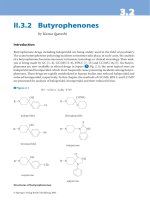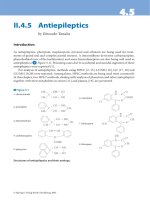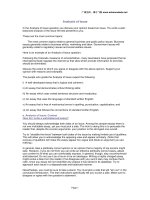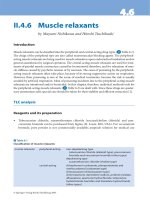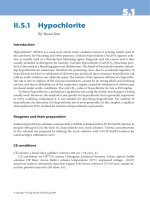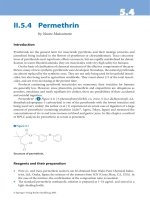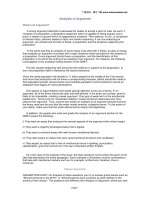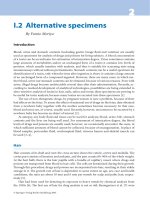Project Analysis Under Certainty pptx
Bạn đang xem bản rút gọn của tài liệu. Xem và tải ngay bản đầy đủ của tài liệu tại đây (723.56 KB, 15 trang )
1
Ch 6 Project Analysis Under
Certainty
Methods of evaluating projects when
the future is assumed to be certain.
2
Introduction
The ideal investment decision making
technique is Net Present Value.
N P V measures the equivalent present
wealth contributed by the investment.
NPV is given in
NPV relates directly to the rm’s goal of
wealth maximization
employs the time value of money
can be used in all types of
investments
can be adjusted to incorporate risk.
3
Other Project Evaluation Techniques:
Slide I
Discounted Cash Flow Techniques
Internal Rate of Return – calculates
the discount rate that gives the
project an NPV of $0. If the IRR is
greater than the required rate, the
project is accepted. IRR is given as
% pa.
IO
IRR
CF
IRR
CF
NPV −
+
+
+
=
)1()1(
)(0$
2
2
1
1
4
Other Project Evaluation Techniques:
Slide II
Modified Internal Rate of Return – calculates
the discount rate that gives the project an NPV
of $0, when future cash flows can be re-invested
at the Re-Investment Rate, a rate different from
the IRR. If the MIRR is greater that the
required rate, the project is accepted. MIRR is
given as % pa.
IO
IRR
RIRCF
IRR
RIRCF
NPV
nn
−
+
+×
+
+
+×
=
−
)1(
)1(
)1(
)1(
)(0$
2
)1(
2
1
1
5
Other Project Evaluation Techniques:
Slide III
Non-Discounted Cash Flow Techniques
Accounting Rate of Return- measures the ratio
of annual average accounting income to an
asset base value. ARR is given as % pa.
= % pa.
Payback Period – measures the length of time
required to retrieve the initial cash outlay.
PB is given as number of years.
6
Selection of Techniques: Slide I
NPV is the technique of choice; it satises the
requirements of: the rm’s goal, the time value
of money, and the absolute measure of
investment.
IRR is useful in a single asset case, where the cash
flow pattern is an outflow followed by all positive
inflows. In other situations the IRR may not rank
mutually exclusive assets properly, or may have
zero or many solutions.
7
Selection of Techniques: Slide
II
•
MIRR is useful in the same situations as
the IRR, but requires the extra
prediction of a re-investment rate.
•
ARR allows many valuations of the asset
base, does not account for the time
value of money, and does not relate to
the rm’s goal. It is not a recommended
method.
•
PB does not allow for the time value of
money, and does not relate to the rm’s
goal. It is not a recommended method.
8
The Notion of Certainty
•
Certainty allows demonstration and
evaluation of the capital budgeting
techniques, whilst avoiding the complexities
involved with risk.
•
Certainty requires forecasting, but forecasts
which are certain.
•
Certainty is useful for calculation practice.
•
Risk is added as an adaption of an evaluation
model developed under certainty.
9
Investment Cash Flow Timing
End Of Year cash 7ow timing is
assumed.
Capital Flows
0 1 2 3 4
5
Initial Later
Terminal
Outlay. Outlay
Flow
Operating Flows
0 1 2 3 4
5
Operating Flows.
10
The NPV Process: Slide I
•
Net annual cash 7ows are forecast
for each year of the project.
EOY 0
-900
EOY 1
300
EOY 2
380
EOY 3
600
•
The discount rate is then applied.
-900
1
)06.1(
300
+
2
)06.1(
380
+
3
)06.1(
600
+
11
The NPV Process: Slide II
•
The NPV is calculated.
$503.77$338.19$283.01-$900
NPV = $ 224.97 Positive: the project is acceptable.
12
Other NPV Applications:
Slide I
Asset
Retirement:
Asset
Replacement:
13
Other NPV Applications:
Slide II
•
Optimum cycle length within a replacement chain.
At EOY:
3 6 9 12 15
OR ?
4 8 12 16
14
Other NPV Applications:
Slide III
Correct ranking of mutually exclusive projects.
Where projects have different outlays.
Where projects have different lives.
15
Net Present Value
THE model to use in all investment evaluations.
Other criteria, such as IRR, MIRR, ARR, and
Payback may be used as complementary
measures.
The End
